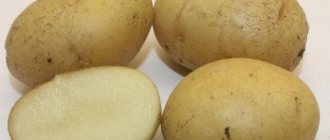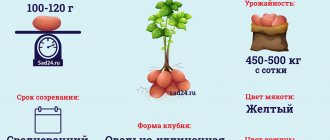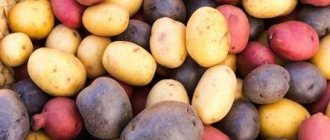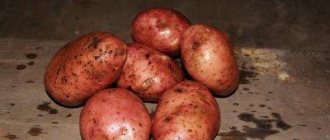With a wide variety of potato varieties, they often choose those that are sold at the nearest spontaneous market or even from cars in bags or buckets. The quality of such planting material can be completely unpredictable. Usually, after several attempts to grow a more or less decent harvest, novice gardeners turn to more experienced people for advice. And, of course, they are advised to first try to get tubers of several old proven varieties of different ripening periods and, as they gain experience, choose the most suitable potato for growing.
The Ilyinsky potato may well serve as one of these varieties, with the cultivation of which a novice gardener can begin to get acquainted with potatoes. It has fairly average characteristics, but many people still like its taste. Therefore, it is grown with pleasure in many regions of Russia.
Origin, description and characteristics
The Ilyinsky potato variety first appeared in the Moscow region, where it was bred by local breeders. The description of this species is similar to other potato varieties, but differs in certain positive features.
Ilyinsky potatoes are a mid-early variety with a short growing season. The first harvest can be harvested within 70-90 days after planting. It is characterized by an average yield - under favorable conditions, 200-300 centners of potatoes are obtained from one hectare. So, from one square meter, gardeners get up to 5 kilos of potatoes.
The variety is well preserved when compared with mid-early varieties, which are not stored for very long. The marketable keeping quality of Ilyinsky potatoes is 93%. It has increased resistance to potato cancer, scab and some viral diseases. But it is quite susceptible to golden nematode and late blight of stems. The tubers are more resistant to late blight.
Ilyinsky potatoes tolerate extreme heat quite well; they are considered a drought-resistant variety.
Characteristics of potato tubers:
- rounded shape, sometimes rounded-oblong, uneven;
- excellent taste;
- small mass of tubers - 60-150 grams;
- average starch content - 15.8-18% (well boiled, but generally retains its shape after heat treatment);
- the skin is red-pink, the flesh is white;
- The eyes are red, small, of medium depth.
When cut raw and after cooking, the potato flesh does not darken. The variety is distinguished by its high marketability, which significantly elevates it over other types of potatoes - 88-99%. This indicator indicates the number of tubers suitable for sale or consumption in relation to the entire harvest.
The table below shows detailed characteristics of the variety:
| Criterion | Characteristic |
| Potato variety | Ilyinsky |
| General characteristics | mid-early variety, characterized by high marketability |
| Productivity | 180-350 c/ha |
| Maturation period | 70-90 days |
| Mass of tubers | 60-150 g |
| How many tubers are in one bush | 8-13 |
| Peel color | red |
| Flesh color | white |
| Starch content | 15,8-18% |
| Keeping quality | 93% |
| Consumer qualities | excellent taste, used for various types of cooking |
| Disease resistance | susceptible to late blight of aerial parts of plants and golden cyst nematode |
| Preferred Growing Regions | Central Black Earth, Middle Volga |
Potato variety Ilyinsky
Ilyinsky is a Russian mid-early potato variety (Solanum tuberosum) for table use. Brought out in the Moscow region by employees of the Federal State Budgetary Institution "All-Russian Research Institute of Potato Farming named after A.G. Lorch." In 1999, it was added to the state register of breeding achievements of the Russian Federation. Zoned in two regions of the country: Central Black Earth (Belgorod, Voronezh, Oryol, Tambov, Kursk, Lipetsk regions) and Middle Volga (Republics of Mordovia and Tatarstan, Samara, Penza, Ulyanovsk regions). It has a high level of marketability. Resistant to drought, capable of producing good yields in extremely hot and dry seasons.
The period from the appearance of full shoots to ripening is 70−80 days.
The plant is of medium height, semi-erect, leafy. The leaves are medium sized, green in color. The leaf is medium. The waviness of the edge of the leaf blade is very weak or absent. Potato inflorescences are small, the corollas are medium sized, and red-violet in color.
Ilyinsky’s root system is quite well developed; 8-13 tubers can form in one nest, each weighing from 54 to 158 grams. The amount of non-commodity items is extremely minimal. The tubers are oval and even in shape; the stolon mark may be slightly depressed. The peel is red, smooth to the touch. The pulp is white when cut. The eyes are small and set at an average depth.
The marketable yield of the variety, according to the results of state tests, is in the range of 176−346 c/ha, which is at the level of 144 c/ha more than Nevsky. In the Lipetsk region, the maximum amount was collected - 355 c/ha, 56 c/ha above the established standard. The marketability of tubers is at an excellent level, comparable to the standard - 87−99%. Keeping quality is also very good - 93%.
The taste of potatoes is excellent. Tubers are versatile in cooking and will work well in any dish. During heat treatment they do not lose their color, so when finished they look very attractive. The pulp contains 15.7-18% starch, which makes Ilyinsky suitable for processing into chips and fries. The puree it makes is great! Gardeners also especially praise it as a young boiled potato.
Our hero is quite demanding of soil and climatic conditions; he feels better on fertile, loose soils in areas with a moderate, mild climate. However, it should be noted that on problematic, but well-prepared soils for cultivation, it shows excellent productivity. Potatoes have good drought resistance and are suitable for cultivation in regions with very hot summers. Of course, soil moisture still needs to be monitored - long-term drought will clearly not benefit the plants.
Ilyinsky is unpretentious in grooming, but responds well to increased attention. Among the nuances of agricultural technology, the need for additional treatments of plantings against late blight should be mentioned. Also, plants do not tolerate excess moisture well in the second half of the growing season, so you should not overdo it with watering at this time. Do not forget about standard agricultural practices, such as hilling, weeding, loosening the soil, and preventive treatments against diseases and pests. Don’t neglect crop rotation either. This is especially important for this variety due to its susceptibility to some nightshade diseases.
Advantages and disadvantages
Ilyinsky potatoes have their own characteristics and some disadvantages. Gardeners need to take this into account in order to provide proper care and avoid some troubles when growing potatoes.
| Advantages | Flaws |
Potatoes are reliably protected from potato cancer, which appears as white growths on tubers and green growths on stems - over time they begin to rot. | Ilyinsky potatoes very often suffer from late blight of stems. It is often attacked by Colorado potato beetles and golden cyst nematodes. Occasionally, mole crickets and wireworms feast on the fruits, leaving traces of their visit. The wireworm leaves small through holes, the mole cricket spoils the appearance of the tubers, sometimes leaving only the peel. |
Preparing for landing
Growing potatoes of the Ilyinsky variety is a simple process if you first choose the right place for planting, prepare the seed, reserve strength and patience to wait for a good harvest.
The soil
Soil for planting potatoes begins to be prepared in the fall. To do this, you should choose a site where nightshade crops have not been cultivated for at least 3 years. Apply rotted manure to the soil surface - 250 kg per 1 hectare. It is recommended to simultaneously sprinkle a complex mineral fertilizer consisting of 1.5 kg of nitroammofosk, 1.5 kg of potassium salt and 2 kg of ammonium nitrate.
If before this there was lush vegetation growing on the site, then there is enough nitrogen in the soil and the percentage of ammonium nitrate in the fertilizer is reduced. After applying fertilizing, the soil is dug deeply or plowed with small mechanical equipment. In spring, the soil is leveled and the beds are prepared.
On loamy soils it is permissible to grow vegetables in high beds, and in other soils in simple rows. A distance of about 60 cm should be left between the rows and placed perpendicular to each other. The distance between the holes should not be less than 30 cm. This arrangement of rows contributes to better illumination of the plants by sunlight.
Seed preparation
Before planting, the tubers are pre-greened and germinated at a temperature of at least +16 degrees, exposing them to light. Germination time is up to 30 days.
Potatoes are planted only after the soil has warmed up to +10 degrees and the potato sprouts are about 4 cm in height. The tubers are treated with the drug Prestige - it protects the plants almost until they bloom. Seed material is placed in holes up to 12 cm deep.
Growing
In the characteristics and reviews of the Ilyinsky variety, it is noted that the best soil for planting the crop will be an area with previously grown forage grasses, winter crops and leguminous crops.
- Tubers are usually planted in May.
- The distance between rows is at least 60 cm, between nests - 30-35 cm.
- According to the description, the Ilyinsky variety needs to be hilled. Hilling is carried out 2-3 times, when the stems rise to 25-30 cm, these procedures must be completed before flowering.
- Since, as emphasized in the description, the potatoes are early, in case of June heat they need to be watered. Water is released into the furrows along the rows.
- If the area is watered, the next day the soil is carefully loosened.
Growing and caring for potatoes
The Ilyinsky potato variety is planted in May. A distance of at least 50 cm is left between plants. For cultivation, well-lit areas with loose and fertile soil are chosen. Organic fertilizers are first applied to the garden bed.
Place several small potato tubers in each hole. If the size is large, it is permissible to cut the potatoes into several parts. It is not recommended to sow potatoes that are too small - they do not have enough nutrients, which is why you will not be able to get a good harvest.
Plants require standard care. It is necessary to regularly loosen the soil to remove weeds. Don't forget about mulching. Do not water the potatoes until the shoots appear, because the spring soil contains enough moisture for the tubers. Watering during this period of development can be dangerous, as the plants are just beginning to form a root system. With active irrigation of plantings, the roots will be located close to the surface, which will result in a decrease in yield. Water the bushes once a week during bud formation.
Features of care
Caring for the variety is not particularly difficult. For the cultivation of Ilyinsky, the specifics associated with the cultivation of mid-early potato varieties are relevant. In addition, it is important to remember the main problems inherent in the variety - diseases and pests, to which Ilyinsky is susceptible.
Fertilizer intensity
If the soil is properly prepared and fertilized before planting the tubers, early ripening potatoes will not need intensive fertilizer. But it is still necessary to apply some fertilizing during the growing season.
Important! The critical time for planting the Ilyinsky harvest is the beginning of August (visually this period can be determined by the beginning of budding and flowering). At this stage, potatoes critically need intensive watering and mineral fertilizers.
Fertilizing Ilyinsky is carried out exclusively by the foliar method (by spraying the bush with an aqueous solution of fertilizer) and may include the use of the following preparations:
| Potassium sulfate or potassium salt | 5–10 g |
| Kalimag (potassium-magnesium fertilizer) | 2–3 g |
| Double superphosphate | 15 g |
| Boric acid | 5–10 g |
| Zinc sulfate | 3–5 g |
| Potassium permanganate | 5 g |
| Copper sulfate | 5 g |
| Magnesium chlorate | 3–5 g |
| Cobalt chloride | 5 g |
| Sodium ammonium molybdate or ammonium molybdate | 5 g |
The consumption rates of the drug in the table above are calculated for 10 liters of water and the treatment of 4–5 bushes.
Watering frequency
Ilyinsky is highly resistant to drought, and therefore is little dependent on the intensity of watering. Moreover, waterlogged soil increases the risk of developing fungal infections, which affect not so much the surface part of the bush, but its roots and tubers.
Important! The volume of water for watering potatoes must be calculated in such a way that it saturates not only the surface layer of soil, but also goes to a depth of at least 40–50 cm.
You can water the garden bed no more than once every 1.5–2 weeks, if there was no rain during this period. Watering should be a little more abundant and frequent during the formation of root crops.
If tap water is used for irrigation, it must first be left standing and warmed in the sun.
Weeding
Weed control is important when growing potatoes. The weed, competing with the plant for nutrients in the soil and sunlight, is a reserve of parasites and fungi, including late blight, which is dangerous for Ilyinsky.
Removal of weeds should be carried out after each watering and combined with loosening the soil, which is necessary to maintain air exchange and moisture retention in it.
We recommend reading about the rules for hilling potatoes.
Caring for the soil on which Ilyinsky grows also includes such a technique as hilling. This procedure not only protects the bush from scattering and laying the stems on the ground, but also allows you to significantly increase the yield of the variety (the maximum number of tubers is formed in a large volume of soil in contact with the bush).
Prevention of diseases and pests
One of the main disadvantages of Ilyinsky is its susceptibility to certain diseases and pests. Of the former, late blight and scab pose the greatest danger to the variety; of the latter, worms (the golden nematode belongs to them), wireworms, mole crickets and Colorado potato beetles.
To prevent the occurrence of this kind of problems, farmers recommend spraying the bushes with copper sulfate, Bordeaux mixture, copper sulfate or manganese sulfate.
If potatoes were previously grown on the site, and the gardener is reliably aware of the presence of nematodes in the soil, immediately after harvesting, experts advise disinfecting the bed with special nematicides in order to destroy the pest and save the crop from it next year. For this purpose you can use (dosage is indicated per 1 m² of area):
- "Heterophos" granules 7.5% - 8 g;
- "Tiazon" powder 85% - 270 g;
- "Carbation" in aqueous solution 40% - 60 ml.
Important! The drugs mentioned are highly toxic and unsafe for the environment, so supporters of organic farming should fight the nematode through proper crop rotation and the use of bioinsecticides.
To combat other diseases and pests, if they appear in the garden, fungicidal and insecticidal preparations are used, for example:
| Against late blight, scab and other fungal infections | Against the Colorado potato beetle and other above-ground pests | Against pests parasitizing root crops |
|
|
|
When using pesticides, it is important to change the product from time to time to prevent the pathogen from developing resistance to a particular pesticide.
Diseases, pests and prevention
Potatoes often suffer from attacks by the Colorado potato beetle. Folk or chemical remedies help fight this pest.
The developers of the variety claim that potatoes often suffer from late blight on the bush. This is an incurable disease. But there is a way to stop its flow and stop the affected plants. It is necessary to spray the shoots with a solution of potassium permanganate or Bordeaux mixture. Experienced gardeners also recommend the use of effective drugs:
- Ridomil MC;
- Oksikhom;
- Ridomil Gold MC.
The golden cyto-forming nematode can also infect Ilyinsky potatoes. The following drugs will help fight it: Medvettox, Gromoboy, Gromoboy-1.
Potatoes of this variety are an ideal plant for beginning gardeners and farmers. The Ilyinsky variety is unpretentious, has a high shelf life, retaining its taste until the new harvest.
Harvest and storage
The harvest is harvested in late August-early September. Young tubers for food consumption are dug much earlier. To store potatoes for storage, they are first left to lie in the ground. Dried and yellowed tops indicate technical ripeness.
It is best to store the harvested crop in a dark, cool room with moderate humidity. In such conditions, tubers are preserved with minimal loss of marketable characteristics, and the surplus is used as planting material in the spring.
Comparison with other varieties
The Ilyinsky potato variety is an excellent mid-season variety, famous for its good yield, ease of care and lack of need for regular watering. For comparison with other varieties, a table with characteristics is presented:
| Variety name | Ilyinsky | Adretta | Bemonda | Breeze | Valentina | Elizabeth | Condor |
| Productivity | 180-350 c/ha | up to 450 c/ha | 280-450 c/ha | 395 c/ha | 280-320 c/ha | up to 400 c/ha | 330-360 c/ha |
| Ripening time | 70-90 days | 70-105 days | 70-75 days | 60-80 days | 70-80 days | 65-80 days | 70-90 days |
| Keeping quality | 93% | 98% | 9;% | 97% | 95% | 93% | 94% |
| Starch | 15,8-18% | 13-18% | 10-13% | 10-16% | 14,5-19% | 13-14% | 9-14% |
| Peel | Red | Yellow | Red | Yellow | Yellow | White | Red |
| Pulp | White | yellow | Light yellow | Yellow | Light yellow | White | Yellow |
| Advantages | Resistance to potato blight. High yield. Preservative qualities. | Develops quickly in the initial period. Relative resistance to viral diseases. | Responsiveness to the level of agricultural technology. High yield. | Good taste. Early tuber formation. | Great taste. High keeping quality. Resistance to potato blight. | Beautiful and tasty tubers. Good storage. Resistance to potato blight. | Increased resistance to common scab. Excellent taste and external qualities. |
| Flaws | Low immunity to golden cyst nematode. Suffering from attacks by the Colorado potato beetle. | Low resistance to late blight. | Susceptibility to late blight. Average resistance to viruses. | Susceptibility to golden cyst nematode. Low resistance to late blight and scab. | Susceptibility to golden cyst nematode. | Average resistance to late blight. | Susceptibility to late blight. |
Reviews
Today, many gardeners write their reviews about the Ilyinsky potato variety. Some speak positively about it, some highlight its shortcomings. But, in general, most of them are praised for their high yields.
★★★★★
Lyudmila, 37 years old, farmer. I have a large plot of land at my dacha.
I cultivate several varieties of potatoes on it, but the earliest is Ilyinsky. At the beginning of July I start digging up root crops. What makes me happy are the large potatoes, even and of the same size. During the entire period of cultivation, the plants have never been exposed to disease. Only the Colorado potato beetle attacked - I treated the tops with special preparations. My family loves this variety of mashed potatoes. ★★★★★
Victor, 44 years old, businessman. For the first time, my mother’s friend told me about Ilyinsky potatoes.
I have a large empty plot. So I decided to try growing a vegetable. It turned out that you don’t need to take special care of it, and growing it doesn’t require any special expenses. I store root vegetables in the basement almost until the beginning of April - they do not germinate. My wife prepares delicious salads, bakes potatoes in the oven and even makes delicious chips. In addition, I decided to start a business - selling potatoes. I am good at this, and the business turned out to be profitable. ★★★★★
Anna, 39 years old, summer resident. A neighbor in my dacha gave me Ilyinsky potatoes for planting five years ago.
Since then I have grown only this variety. Modern hybrids don't seem so good to me, because today's potatoes contain a lot of GMOs. I prefer healthy and natural food. This variety has already been tested by me personally, and it always pleases with a good harvest. The only difficulties that I sometimes have to face are summer treatments for pests and diseases. But it's worth it! Hide
Add your review
Potatoes of the Ilyinsky variety delight with their taste and consistently large yield. It is not difficult to grow; care requires minimal knowledge. Having planted it once, gardeners no longer want to try other varieties. With the right approach, you can get a harvest every year and have a large supply of potatoes for the winter.
0
0
Copy link
Potatoes Ilyinsky
There is probably not a single person who does not like potato dishes. It contains a large amount of vitamins and microelements that are beneficial for the body. There are especially many of them in new potatoes. The Ilyinsky variety has gained great popularity, having established itself as high-yielding, having excellent taste and presentation.
Description of Ilyinsky potatoes
The Ilyinsky potato was bred in 1999 by Russian breeders. It is recommended for cultivation in the Central Black Earth and Volga regions, as well as for Ukraine and Moldova. The plant has medium height, stems spreading from the center. The inflorescences are small, red-violet in color. The fruits have the following characteristics:











